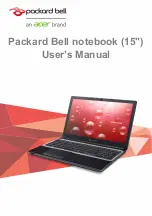
When the computer deletes a program, it does not immediately delete it. It
marks that area of the disk as available for use. As you store more data,
that area might be overwritten (where a file is stored is random). If not
much data has been stored since the file was deleted, you can usually
recover all or part of that file. There are various utility programs that can
be used for such recovery. If you ever accidentally erase a file, you should
look into obtaining such a program.
Very few people ever know exactly where every document on their hard
drive can be found. Sometimes you will need to find a document. Many
applications have such a function built-in. If the one you are using does not,
you can use the find function built into Windows 98 (Start/Find). Files can
be located by name (if you remember it), or by some text or data contained
in the file, or by the date the file was last used. For more information about
using find functions, see the Windows 98 documentation or the documenta-
tion that came with your application.
In addition to storing files on your hard drive, you may also choose to store
them (or copy them) on diskettes. You computer will use diskettes (usually
3.5” diskettes) as secondary storage media. Secondary storage means that
they are stored outside the memory of your computer. (Your primary storage
medium is your hard drive.) Data is stored on diskettes as magnetic fields.
Your WinBook XL2 system came equipped with a 3.5” diskette drive or an
LS-120 drive capable of reading 3.5” diskettes. To read data from or write
data to your diskette, insert your diskette into the drive. You will need to tell
your software which drive to read from and write to (A:, unless you have
changed the designation). A read/write head inside the drive will now be
lowered and the diskette spun to allow access to its surface.
Always handle a diskette by its case. Do not touch the media inside the
diskette. If possible, write on the label before placing it on the diskette. If
you must write on the label while it is on the diskette, use a soft pen (such
as a felt-tip pen). The information on a disk is stored as a magnetic field,
and thus diskettes can be damaged or information erased by exposure to
User’s Manual
2.10
If the disks you buy are
not formatted, you will
need to format them. This
prepares the disk for the kind of
data storage used by your oper-
ating system. See the Windows
98 documentation for informa-
tion on how to do this.
Summary of Contents for XL2
Page 1: ...User s Manual for notebook computers ...
Page 6: ...Table of Contents 6 Table of Contents ...
Page 11: ...Preface v ...
Page 13: ...Chapter One Getting Started Chapter 1 Getting Started 1 1 ...
Page 40: ...Chapter Two Basic Computing Chapter 2 Basic Computing 2 1 ...
Page 60: ...Chapter Three Mobile Computing Chapter 3 Mobile Computing 3 1 ...
Page 80: ...Chapter Four Desktop Operation Chapter 4 Desktop Operation 4 1 ...
Page 98: ...Chapter 4 Desktop Operation 4 19 ...
Page 99: ...Chapter Five PC Cards PCMCIA Chapter 5 PC Cards PCMCIA 5 1 ...
Page 113: ...Chapter Six Video Settings Chapter 6 Video Settings 6 1 ...
Page 123: ...Chapter Seven Upgrading Chapter 7 Upgrading 7 1 ...
Page 135: ...7 13 Chapter 7 Upgrading ...
Page 160: ...Chapter Nine Troubleshooting Chapter 9 Troubleshooting 9 1 ...
Page 187: ...Glossary Glossary G 1 ...
Page 204: ...Index Index I 1 ...
Page 211: ...WinBook Corporation 2701 Charter Street Hilliard Ohio 43228 ...
















































